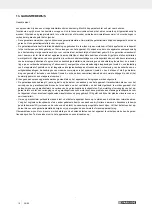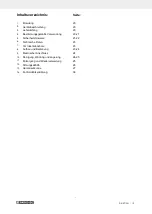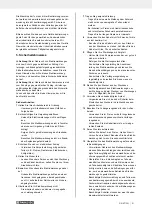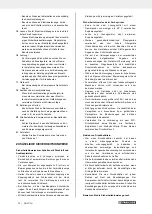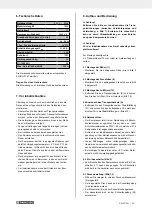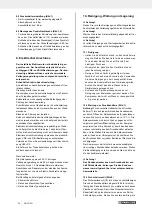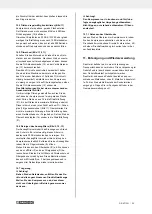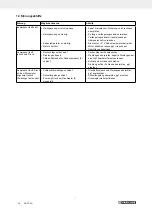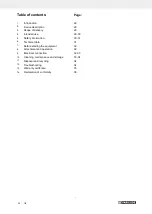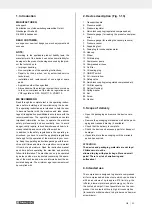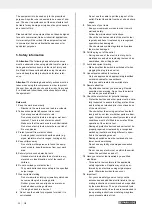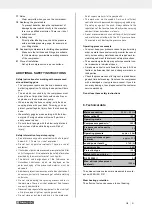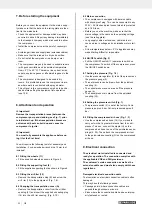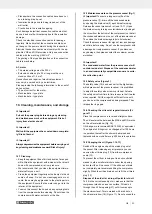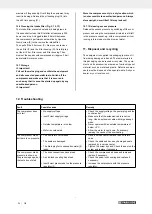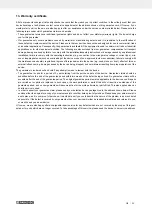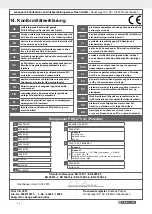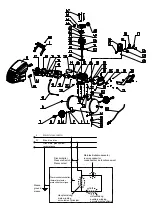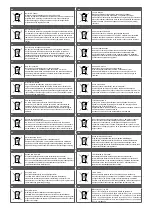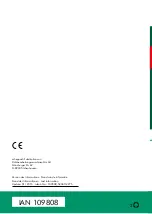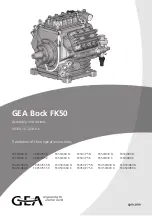
32
GB
7. Before starting the equipment
Before you connect the equipment to the mains supp-
ly make sure that the data on the rating plate are iden-
tical to the mains data.
•
Check the equipment for damage which may have
occurred in transit. Report any damage immediately
to the transport company which was used to deliver
the compressor.
•
Install the compressor near the point of consumpti-
on.
•
Avoid long air lines and supply lines (extension cables).
•
Make sure that the intake air is dry and dustfree.
•
Do not install the compressor in a damp or wet
room.
•
The compressor may only be used in suitable rooms
(with good ventilation and an ambient temperature
from +5 °C to 40 °C). There must be no dust, acids,
vapors, explosive gases or inflammable gases in the
room.
•
The compressor is designed to be used in dry
rooms. It is prohibited to use the compressor in are-
as where work is conducted with sprayed water.
•
The oil level in the compressor pump has to be che-
cked before putting the equipment into operation
(see 10.4).
8. Attachment and operation
n
Important!
Remove the transportation braces (between the
compressor pump and cladding, see Fig. 7) prior
to initial start-up. If the transportation braces are
not removed, heat can build up and cause the
compressor to ignite.
n
Important!
You must fully assemble the appliance before us-
ing it for the fi rst time!
You will require the following tools for assembly and
installation: 2 x open-ended wrench size 13 mm (not
included)
8.1 Fitting the wheels (11)
•
Fit the supplied wheels as shown in Figure 5.
8.2 Fitting the supporting foot (8
)
•
Fit the supplied supporting foot as shown in Figure 6.
8.3 Fitting the air filter (15)
•
Remove the transportation stop (B) and screw the
air fi lter (15) to the equipment. (Fig. 7, 8).
8.4 Changing the transportation cover (A)
•
Remove the transportation cover from the oil filter
opening (21) and insert the supplied oil sealing plug
(16) into the oil fi ller opening. (Fig. 9, 10.)
8.5 Mains connection
•
The compressor is equipped with a mains cable
with shock-proof plug. This can be connected to any
230V ~ 50 Hz shock-proof socket which is protected
by a 16 A fuse.
•
Before you use the machine, make sure that the
mains voltage is the same as the operating voltage
(see the rating plate).
•
Long supply cables, extensions, cable reels etc.
cause a drop in voltage and can impede motor start-
up.
•
At low temperatures below +5°C, sluggishness may
make starting difficult or impossible.
8.6 ON/OFF switch (Fig. 2)
•
Pull the ON/OFF switch (17) upwards to switch on
the compressor. To switch off the compressor, press
the ON/OFF switch down.
8.7 Setting the pressure (Fig. 1-3)
•
Use the pressure regulator (3) to set the pressure on
the pressure gauge (5).
•
The set pressure can be drawn from the quicklock
coupling (4).
•
The vessel pressure can be read off the pressure
gauge (6).
•
The vessel pressure is drawn from the quicklock
coupling (20).
8.8 Setting the pressure switch (Fig. 1)
•
The pressure switch (2) is set at the factory. Cut-in
pressure approx. 6 bar Cut-out pressure approx. 8
bar.
8.9 Fitting the compressed air hose (Fig. 1, 3)
•
Use the compressed air hose (14) if you intend to
carry out work at a greater distance from the com-
pressor. To do so, connect the nipple (H) on the
compressed air hose to one of the quickrelease cou-
plings (4, 20). Then attach the compressed air tool
to the quick-release coupling (G) on the compressed
air hose.
9. Electrical connection
The electrical motor installed is connected and
ready for operation. The connection complies with
the applicable VDE and DIN provisions.
The customer‘s mains connection as well as the
extension cable used must also comply with these
regulations.
Damaged electrical connection cable
The insulation on electrical connection cables is often
damaged.
This may have the following causes:
•
Passage points, where connection cables are
passed through windows or doors.
•
Kinks where the connection cable has been improp-
erly fastened or routed.

